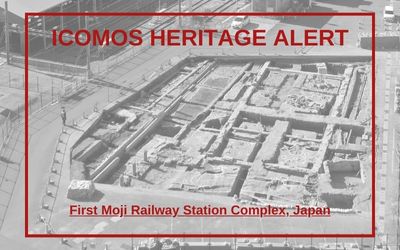Heritage Alert First Moji Railway Station Complex, Japan
 ICOMOS, together with its Japanese National Committee, is issuing a Heritage Alert to stop the construction plans threatening the integrity and scientific value of the archaeological remains of the First Moji Railway Station complex in Kitakyushu City, Japan. ICOMOS demands a reassessment of the development plan and a comprehensive conservation of the remaining sections of the complex.
ICOMOS, together with its Japanese National Committee, is issuing a Heritage Alert to stop the construction plans threatening the integrity and scientific value of the archaeological remains of the First Moji Railway Station complex in Kitakyushu City, Japan. ICOMOS demands a reassessment of the development plan and a comprehensive conservation of the remaining sections of the complex.
The archaeological remains of the First Moji Railway Station Complex, located near Moji Port in Kitakyushu City, Fukuoka Prefecture, Japan, are under imminent threat due to planned construction of a five-story complex featuring several public facilities by the municipal government. Discovered during a rescue excavation in early 2023, the remains represent a crucial chapter in Japan’s railway history and the broader narrative of the nation’s modernization. Their destruction would result in the loss of an irreplaceable element of Japan's cultural heritage.
Excavated area of the first Moji Railway Station Complex
Photo credits: Kitakyushu City Foundation for Promoting Arts and Culture
Historic Significance
- Railway History: Opened in 1891, the First Moji Railway Station Complex was a cornerstone of Japan's early railway network, serving as the terminus station on the northeastern edge of Kyushu Island. It played a key role in the rapid expansion of Japan's railways following the establishment of the country’s first railway in 1872. These remains stand as a testament to Japan's transformation into a modern industrial nation.
- Urban Development: The concurrent planning and construction of Moji Port and the railway station in 1889 were pivotal in transforming Moji into a model modern city and a significant trading hub in Asia. The station remains are not only symbols of economic growth but also bear witness to the complex history of the region, including the transportation of soldiers and resources during times of conflict.
Architectural and Engineering Significance
The site exhibits a unique blend of modern Western and traditional Japanese construction techniques, reflecting Japan's transition from pre-modern to modern engineering practices. This is exemplified by the exceptionally well-preserved structures, such as the engine shed’s foundation, which has remained intact since the station’s inception in 1891.
Integrity and Scientific Value
The integrity of the site is underscored by the coexistence of excavated remains and those still buried, alongside existing structures like the former headquarters of Kyushu Railway (now the Kyushu Railway Heritage Museum) and the second Moji Station Building (Mojiko Station). Together, these elements provide a comprehensive view of the original layout and design, offering invaluable insights into the master plan of the old city. The spatial relationships among the port facilities further highlight the site’s exceptional value.
From a scientific perspective, the site holds enormous potential. With only a small portion excavated so far, future investigations are expected to reveal additional remains, offering deeper insights into the station’s development and operations. These findings could significantly enhance our understanding of Japan's early industrial era.
Call to Action
Since November 2023, numerous petitions have been submitted by local communities, academic associations, and ICOMOS Japan, urging the City of Kitakyushu to reconsider its construction plans. ICOMOS also already sent a first letter on 25 June 2024. Despite these concerted efforts, the city has yet to engage in meaningful and transparent dialogue - which is why ICOMOS is now launching this international Heritage Alert. To safeguard this heritage of both national and international significance, it is imperative that the construction project be halted immediately. A comprehensive archaeological investigation should be undertaken, and a committee comprising municipal staff, citizens, professionals, and academics should be established to explore sustainable solutions that balance the need for public facilities with the imperative of heritage conservation.![]() Download the press release
Download the press release
![]() Read the second letter sent to government and city officials
Read the second letter sent to government and city officials
![]() Read the letter sent to Kitakyushu government and administration officials
Read the letter sent to Kitakyushu government and administration officials
See also![]() Current Heritage Alerts
Current Heritage Alerts

